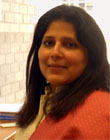 The 16th International AIDS Conference starting in Toronto this Sunday will attract some 24,000 delegates from 132 countries, celebrities and entertainers including The Blue Man Group, Bill Clinton, Bill and Melinda Gates, 3,000 journalists, and an army of researchers scheduled to present more than 4,500 scientific papers. Nandini Oomman, director of the Center for Global Development's HIV/AIDS Monitor, explains what she hopes to learn--and share--at the upcoming conference.
The 16th International AIDS Conference starting in Toronto this Sunday will attract some 24,000 delegates from 132 countries, celebrities and entertainers including The Blue Man Group, Bill Clinton, Bill and Melinda Gates, 3,000 journalists, and an army of researchers scheduled to present more than 4,500 scientific papers. Nandini Oomman, director of the Center for Global Development's HIV/AIDS Monitor, explains what she hopes to learn--and share--at the upcoming conference.
Q: What purpose is served by such a large and expensive gathering--can it make a difference to the 39 million people infected with HIV?
A: Absolutely. The International AIDS Conference is the only forum where people from around the world involved in responding to the epidemic from a wide variety of backgrounds gather for six days to take stock of successes and failures. We learn from research results and program policy experiences in order to improve the global response. For example, medical practitioners learn from clinical researchers whether a new drug can slow the infection or relieve symptoms from secondary infections. Clinical researchers in turn learn from epidemiologists about how many people are HIV positive, and how many are sick and dying. Social and behavioral scientists present information about behaviors that can prevent HIV transmission and increase adherence to treatment regimens. Meanwhile policymakers use scientific evidence they learn about at the conference to design policies that increase access to prevention and treatment programs. While it’s true that in our age of electronic communications all sorts of information is at our fingertips, the conference offers energy and passion that cannot be captured online. Given that millions of lives are at stake, and that donor countries alone are spending about $8 billion a year to respond to the epidemic, having this type of intensive and extensive information exchange every other year strikes me as a good investment.
Q: The conference theme is Time to Deliver. The three funding initiatives that the Center for Global Development's HIV/AIDS Monitor tracks--the Global Fund, PEPFAR, and the World Bank’s Multi-country HIV/AIDS Program (MAP) for Africa--together account for about $5 billion of the $8 billion spent last year to confront the epidemic. How are these funding mechanisms performing?
A: This is the central question a team of researchers at CGD are attempting to answer through the HIV/AIDS Monitor. Rigorous information about donor performance for HIV/AIDS is not easily available. The conference will provide an opportunity to hear from two of the three big donors--the Global Fund and the World Bank. Perhaps surprisingly, the conference agenda does not include much discussion of donor effectiveness, so I am especially looking forward to a pre-conference panel discussion organized by the International AIDS Economic Network on evaluating donor programs. Indirect evidence about donor effectiveness will emerge from presentations about interventions promoted by donors, implementation processes at the country level, and how global policies play out at the country level, to name just a few. The HIV/AIDS Monitor will release a series of working papers on donor performance, disbursement issues, and critical issues in the logistics and supply chain management this fall.
Q: If you could address the 24,000 assembled delegates, what would you say?
A: The AIDS 2006 Conference theme, Time to Deliver, emphasizes the need to bring effective HIV prevention and treatment strategies to communities around the world. This can only happen if you:
- Put your money where there is evidence of policies and programs that work.
- Focus on prevention as much as you focus on scaling up treatment.
- Prepare now to learn systematically whether your investments are paying off.
Q: What do you hope to learn at the conference?
A: The many different tracks at the conference make it an ideal one-stop shop to learn about advancements in medical science, programs and policy. While I am primarily concerned with finding out more about the three big donor programs, I am also hoping to learn about scientific breakthroughs concerning the virus itself; new technologies to assist in testing, diagnoses and treatment; innovative ways to help women overcome the higher risks and greater barriers to testing and treatment that they face; and the growing role of the private sector in responding to the epidemic. Three colleagues from the Center will join me in attending the conference; stay tuned for our updates on CGD's Global Health Policy blog!

